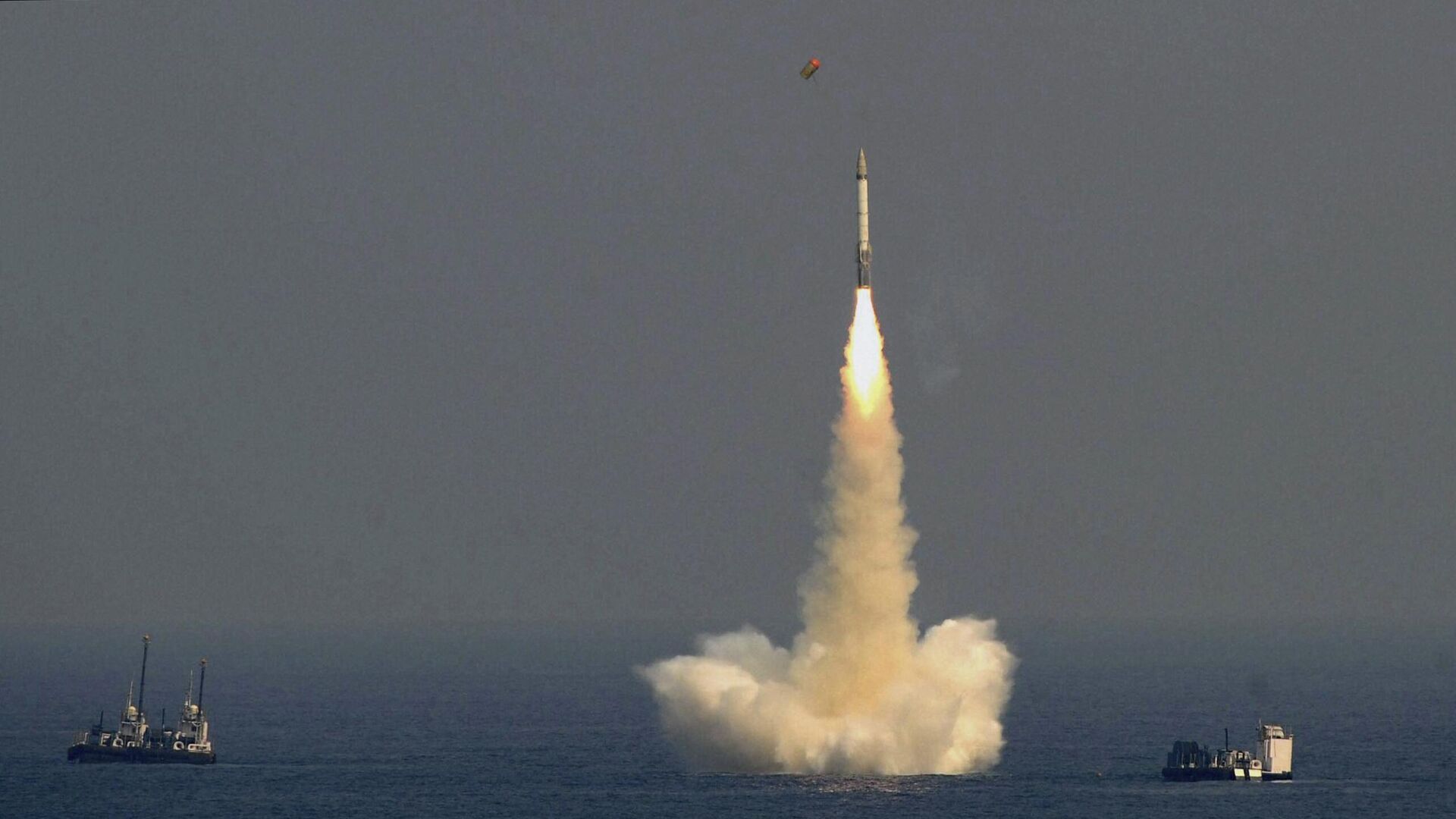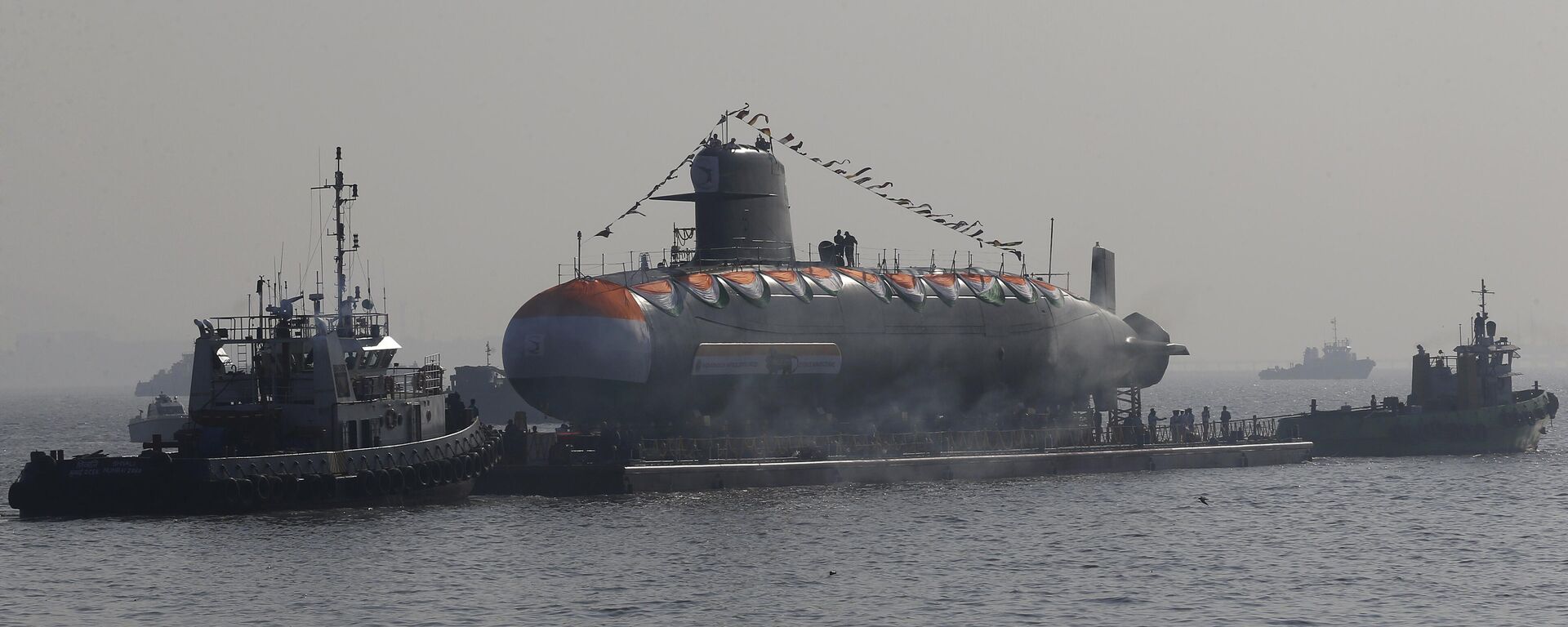https://sputniknews.in/20241128/new-missile-launch-coined-game-changing-leap-for-indias-nuclear-deterrence-8466131.html
New Missile Launch Coins Game-Changing Leap for India's Nuclear Deterrence
New Missile Launch Coins Game-Changing Leap for India's Nuclear Deterrence
Sputnik India
The K-4 missile, developed by the DRDO, has a strike range of 3,500 km, significantly boosting India’s second-strike capability and reshaping the strategic balance in South Asia and the Indo-Pacific region.
2024-11-28T20:34+0530
2024-11-28T20:34+0530
2024-11-29T12:24+0530
defenсe news
india
indian ocean
south asia
defense sector
self-defense
submarine
nuclear-powered attack submarine
nuclear submarine
indian navy
https://cdn1.img.sputniknews.in/img/07e8/0b/1c/8467597_0:0:2567:1444_1920x0_80_0_0_d76cb7265533826ad2a4718f54895168.jpg
India’s successful launch of the nuclear-capable K-4 submarine-launched ballistic missile (SLBM) from the newly commissioned INS Arighaat submarine represents a significant milestone in the country’s defence strategy, experts have concluded.The launch of the Defence Research and Development Organisation (DRDO)-designed missile is a game-changer for India’s enhancing nuclear deterrence capabilities, along with adding technological prowess to the country, Seshadri Vasan, a retired commodore and Indian Navy veteran, told Sputnik India.India’s missile systems initially had more limited ranges, which restricted its operational flexibility. However, the introduction of the K-4 marks a significant shift, he stated, adding that over time, India has steadily extended the range of its missiles, particularly those launched from submerged nuclear submarines.The success of INS Arighaat plays a crucial role in this progress: with a range of 3,500 km, the K-4 further strengthens this capacity, providing the nation with the flexibility to target critical locations not only within its immediate region but also across vast expanses of the Indian Ocean, while adapting to shifting thresholds of engagement in any future conflict, Vasan said.The K-4 missile is a remarkable advancement over India’s earlier missile systems, particularly in the complexity of launching from a submerged platform."Launching a missile from underwater presents a unique set of challenges, as it must transition from the denser medium of water to the rarer one of air," Vasan explained. "This requires advanced engineering to ensure a smooth launch and a seamless transition into the atmosphere before re-entering the earth’s surface."Additionally, advancements in booster technology have increased the missile's range, while the sophistication of the warhead design continues to evolve."The missile’s warhead design has also evolved, with future capabilities potentially including multiple independently targetable re-entry vehicles (MIRVs) and other advanced configurations. These technological enhancements ensure that the missile can engage multiple targets and adjust to operational conditions, such as sea-skimming capabilities and changes in altitude," Vasan concluded.
https://sputniknews.in/20240813/whats-driving-the-indian-navys-ambition-for-more-nuclear-attack-submarines-8003815.html
india
indian ocean
south asia
indo-pacific
Sputnik India
feedback.hindi@sputniknews.com
+74956456601
MIA „Rossiya Segodnya“
2024
Sangeeta Yadav
https://cdn1.img.sputniknews.in/img/07e6/0c/0f/110602_0:0:641:640_100x100_80_0_0_c298016a79eb02ef8caa9d1f688c12a5.jpg
Sangeeta Yadav
https://cdn1.img.sputniknews.in/img/07e6/0c/0f/110602_0:0:641:640_100x100_80_0_0_c298016a79eb02ef8caa9d1f688c12a5.jpg
News
en_IN
Sputnik India
feedback.hindi@sputniknews.com
+74956456601
MIA „Rossiya Segodnya“
Sputnik India
feedback.hindi@sputniknews.com
+74956456601
MIA „Rossiya Segodnya“
Sangeeta Yadav
https://cdn1.img.sputniknews.in/img/07e6/0c/0f/110602_0:0:641:640_100x100_80_0_0_c298016a79eb02ef8caa9d1f688c12a5.jpg
k-4 missile launch, game-changer, india's nuclear deterrence, defence research and development organisation, drdo, south asia, submarine-launched ballistic missile, slbm, ins arighaat, seshadri vasan, retired commodore, indian navy veteran, defense strategy, indian ocean, strategic forces command, technological advancements missile range, warhead, mirvs, indo-pacific
k-4 missile launch, game-changer, india's nuclear deterrence, defence research and development organisation, drdo, south asia, submarine-launched ballistic missile, slbm, ins arighaat, seshadri vasan, retired commodore, indian navy veteran, defense strategy, indian ocean, strategic forces command, technological advancements missile range, warhead, mirvs, indo-pacific
New Missile Launch Coins Game-Changing Leap for India's Nuclear Deterrence
20:34 28.11.2024 (Updated: 12:24 29.11.2024) The K-4 missile has a strike range of 3,500 km, significantly boosting India’s second-strike capability and reshaping the strategic balance in South Asia and the Indo-Pacific region, an expert told Sputnik.
India’s successful launch of the nuclear-capable
K-4 submarine-launched ballistic missile (SLBM) from the newly commissioned
INS Arighaat submarine represents a significant milestone in the country’s defence strategy, experts have concluded.
The launch of the Defence Research and Development Organisation (DRDO)-designed missile is a game-changer for India’s enhancing nuclear deterrence capabilities, along with adding technological prowess to the country, Seshadri Vasan, a retired commodore and Indian Navy veteran, told Sputnik India.
"This successful launch is part of India’s broader commitment to strengthening self-sufficiency in defence and expanding our second-strike capabilities," Vasan emphasised.
India’s missile systems initially had more limited ranges, which restricted its operational flexibility. However, the introduction of the K-4 marks a significant shift, he stated, adding that over time, India has steadily extended the range of its missiles, particularly those launched from submerged nuclear submarines.
The success of INS Arighaat plays a crucial role in this progress: with a range of 3,500 km, the K-4 further strengthens this capacity, providing the nation with the flexibility to target critical locations not only within its immediate region but also across vast expanses of the Indian Ocean, while adapting to shifting thresholds of engagement in any future conflict, Vasan said.
“While India does not seek conflict, it is essential to be prepared, and this missile launch is an integral part of the broader strategic puzzle. As we move forward, the K-4 will become a key part of the Strategic Forces Command, reinforcing our confidence in managing equations with our nuclear adversaries,” Vasan said.
The K-4 missile is a remarkable advancement over India’s earlier missile systems, particularly in the complexity of launching from a submerged platform.
"Launching a missile from underwater presents a unique set of challenges, as it must transition from the denser medium of water to the rarer one of air," Vasan explained. "This requires advanced engineering to ensure a smooth launch and a seamless transition into the atmosphere before re-entering the earth’s surface."
The success of the K-4's underwater launch also highlights India's increasing proficiency in deploying missiles from nuclear-powered submarines, further strengthening the nation's strategic deterrence capabilities, he asserted.
Additionally, advancements in booster technology have increased the missile's range, while the sophistication of the warhead design continues to evolve.
"The missile’s warhead design has also evolved, with future capabilities potentially including multiple independently targetable re-entry vehicles (MIRVs) and other advanced configurations. These technological enhancements ensure that the missile can engage multiple targets and adjust to operational conditions, such as sea-skimming capabilities and changes in altitude," Vasan concluded.



